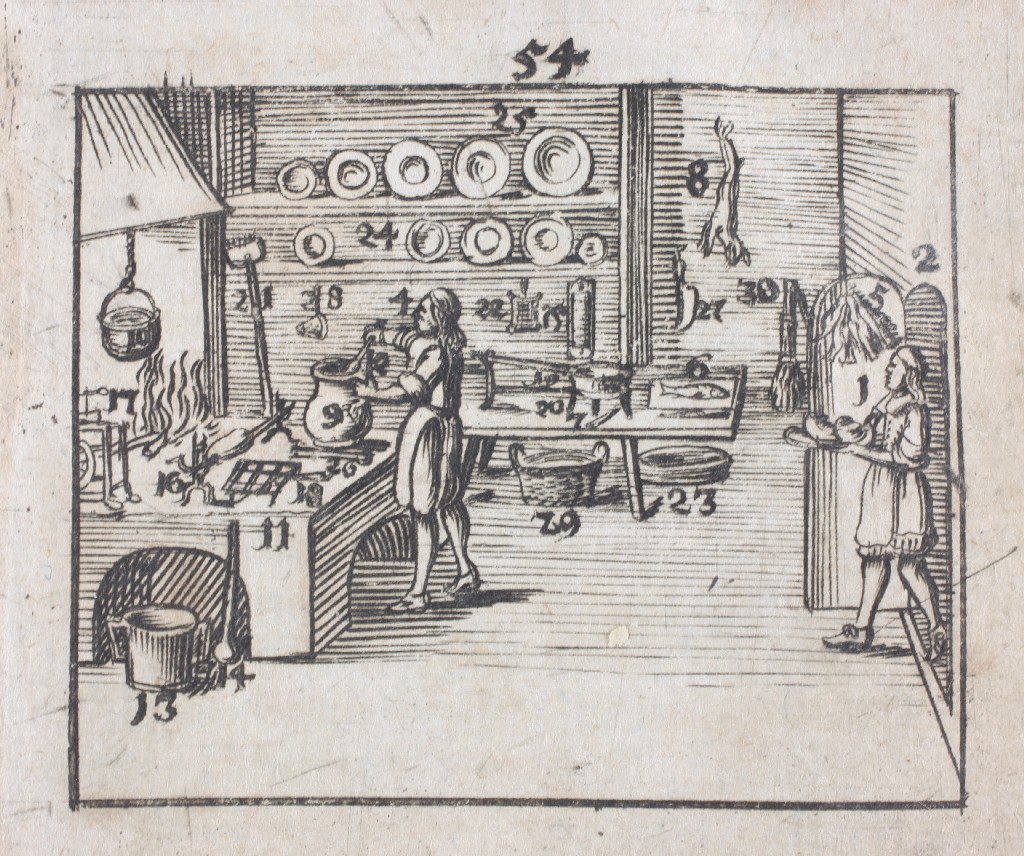
One of features characteristic for inhabitants of the Commonwealth, pointed out by Bernard O’Connor, was their love of banquets. It was so ubiquitous that he remarked the following, ‘Every Person of any Fashion, has his Banquetting Hall in his House, peculiarly set a-part for Feasts and Entertainments.’ Everyone feasted to the best of their abilities, with peasants and poor gentry having to satisfy themselves with unsophisticated food, of which meat constituted a real treat. Wealthy nobles and townsmen went out of their way to give sumptuous parties meant to testify to their wealth and high social standing. Plentiful food was not enough. One had to serve it in such a way as to surprise the guests. The surprise effect could be achieved by means of a symbolic number of dishes, as was the case with Paweł Jan Sapieha’s banquet held in the time of King Władysław IV’s reign, where there was ‘a herd of four massive boars representing the four seasons... There was a tandem of twelve roasted deer... corresponding with the twelve months. Displayed all around there were lengthy cakes equalling the annual number of weeks... These were followed by 365 items of baking, symbolizing the annual number of days... A tandem of silver watering cans... exemplum 12 months. A tandem of 52 silver kegs in gratiam 52 weeks... Further up, 365 demijohns of Hungarian wine, alias as many as there are days in a year. And for the court servants as many as 8700 quarts of mead, equalling the annual number of hours.’ Most frequently however the desired effect was achieved through a fancy presentation of food. Here is a description of one of many 16th-century cakes served at a party thrown by Mikołaj Chroberski, a Cracow councillor: ‘Other pieces of baking represented miscellaneous phenomena. I was amused by a representation of a bath; in the middle of a cake there was a pond of white mead, small fish and nymphs bathing and Cupid shooting at them with his bow; instead of aiming at their hearts, gracious me, the shameless deity shot at their charming eyes which they covered out of embarrassment.’ Even more peculiar was the service of Easter food blessing at Prince Mikołaj Krzysztof Radziwiłł’s, wherein ‘the first room contained three huge pâtés; on spotting them, the prince shouted, “Gentlemen, into attack.” Having said that, he removed a hat from the top of the first pâté. Instantly a great number of living partridges, waxwings, doves, hazel grouse and ortolans flew up from under the hat... Dressed as rocks, ladies wore on their heads almond constructions of grottos and strongholds; one even resembled Jerusalem… In passageways there were sugar statues on guard in enamelled suits with red crosses on their chest, resembling the knights of Jerusalem of Gudfred’s time.’ Foreigners might not have liked the meals themselves as they often found them too spicy, but they were invariably much impressed by the food presentation. Jean de Labourer, a French travel companion of Marie Louise Gonzaga, wife of King Władysław IV, wrote the following account of his visit to the Commonwealth paid in 1646, ‘I returned to the same room over and over again out of curiosity and may say with all certainty that the platters constantly surrounded by people brought to my mind the marriage at Cana. On top of mostly gilded pâtés there were faithfully executed figures of pâtéd animals with real feathers plugged into them or fur tucked on top, very skilfully… presented on the platters.’ But all these ideas were beaten by ‘Capon roasted so as to fly off the table’. Admittedly, it was not an expensive meal. It was neither covered with gilding, nor did it contain a pond of white mead in the middle, or resemble Jerusalem. Nevertheless, it was greatly impressive… ‘Get it [the capon] drunk on vodka or wine, then douse it with strong vodka so as to facilitate the process of feather plucking. Then arrange its wings and legs for roasting and place on a wooden gridiron far from the fire. When the capon has browned well from both sides, spread fresh butter on top and serve. When touched with a fork, it will leap and jump off the table, to the guests’ great admiration.
We would like to inform that for the purpose of optimisation of content available on our website and its customisation according to your needs, we use information stored by means of cookies on the Users' end devices. You can control cookies by means of your Internet browser settings. Further use of our website without change of the browser settings means that you accept the use of cookies. For more information on cookies used by us and to feel comfortable about this subject, please familiarise yourselves with our Privacy Policy.
✓ I understand